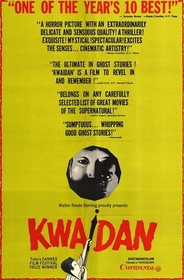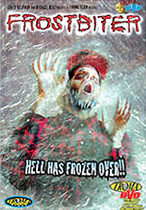Our editor-in-chief Nate Yapp is proud to have contributed to the new book Hidden Horror: A Celebration of 101 Underrated and Overlooked Fright Flicks, edited by Aaron Christensen. Another contributors include Anthony Timpone, B.J. Colangelo, Dave Alexander, Classic-Horror.com's own Robert C. Ring and John W. Bowen. Pick up a copy today from Amazon.com!
Kwaidan (1964)
Unless you have a great independent video store, it's going to be difficult to find Japanese masterpiece Kwaidan for rental. Not to worry, though. It is available to buy from many Internet stores, and for a film this grand, purchase is almost necessary. As a film that transcends its cultural barrier to become a horror film for the international community, Kwaidan is a must-have component of a serious collector's cache
Visuals and symbols have the same emotional impact no matter where a film is made. The imagery here is simply phenomenal. Spooky, disturbing...the kind of stuff that sends a shock through your system...that feeling that sends you huddling closer to the person you're watching with, even when nothing is happening. I thought that Werner Herzog's Nosferatu: Phantom der Nacht had the best cinematography in a horror film, but not so. It is Kwaidan.
"Okay, Nate... you're babbling again. What the hell IS Kwaidan?" Well, the title literally means "Ghost Story," and that's just what the movie is...an anthology of four supernatural stories (adapted from the works of Greek expatriate Lafcadio Hearn, aka Koisumi Yakumo) set in feudal Japan, each one much like a twisted children's tale.
Black Hair:
In this, the best of the four stories, a samurai abandons his first wife in order to gain social status. When he finds his second wife, the daughter of an affluent family, to be selfish and shallow, he returns to his former home to find something not quite right. The ending is quite the shocker, almost in the manner of one of the British Amicus anthologies, but with its own twist. Atmospherically shot and extremely creepy...this one will give you nightmares.
The Woman in the Snow:
Two woodcutters are trapped in a blizzard. After they take refuge in an empty shack, they are visited by a woman both strikingly beautiful and deadly. She drains the blood of one and lets the other live on the condition that he tells no-one of what has transpired. If he lets it slip, he's a dead man. Well told, surrealistically shot, and with a great wide-open ending. The only flaw in this entry is the actor portraying the surviving wood-cutter can do relaxed face and shocked face, and that appears to be the extent of his talents. The Snow Woman is chilling, though, and very scary.
Hoichi-the-Earless:
While claiming the coolest title in the whole bunch, this suffers from being the longest of the four stories. While it is beautifully told, it encompasses two separate tales, one of which could have stood a little paring down (or a lot). Hoichi is a young blind man with a skill for singing the story of a great battle. Many want to hear it, including the ghosts of the losing side. Performing for the dead becomes a dangerous experience, and Hoichi's priest friend tries to save him before it is too late. While this is the most artistic of the stories, it also contains some irritating comic relief. Notable for the floating bits of flame which would later pop up in Michele Soavi's Cemetery Man.
In a Cup of Tea:
Probably the most interesting of the stories, as it does something no Western film will. It literally asks you to devise your own ending in your head. A samurai warrior finds a face reflected in his cup of tea one morning. The odd thing is that there isn't a person to be reflected. So the warrior throws out that tea and gets a new cup...with the same face come even closer. A few broken cups later and the warrior gives in and drinks the tea. Later that night, he receives a visitor unlike any he's ever known...who looks oddly like someone he saw just recently. Scary and amusing at the same time, with great camera angles and a bizarre postscript.
Each entry in addition to its own individual strengths benefits from the best sound effects work I have ever encountered. It really heightens the terror that director Masaki Kobayashi brings out with his lens. The creaking sounds in "Black Hair" and the dripping in "In a Cup of Tea" freaked me out as much as the images did.
I do recommend that you watch this, but plan to spend an entire night with it. It runs at 164 minutes, with each segment running roughly 40 minutes (give or take a few). Luckily, much of the story is painted without words, so the subtitle reading is minimal. No horror film aficionado should go without seeing this. It makes you see the genre outside of the standard Western box. You might not like how it does things, but it's a different angle, and that's always appreciated.
Trivia:
The original American release eliminated the second story for a more compact 125 minute running time.









Hi, love your reviews.
Hi, love your reviews. Please, if you liked this as much as you seemed to, please watch and review Mizoguchi's Ugetsu if you haven't already. This and Kwaidan are two of my favorite films, and without a doubt at the top of my list for Japanese horror.
Also not really related to this discussion, but I would love to see a review of The Gate (1987), which I always thought had a little something special as a horror film. The same can be said for Something Wicked This Way Comes (1983). Both of these films really surprised me, where I was expecting 80's cheese (The Gate) or a Disney kiddie flick (SWTWC), I instead got two films that really seem to respect their audience.
Hai Duke, thank you for your
Hai Duke, thank you for your recommendation.. Maybe I will try to watch your movie recommendation.. :D